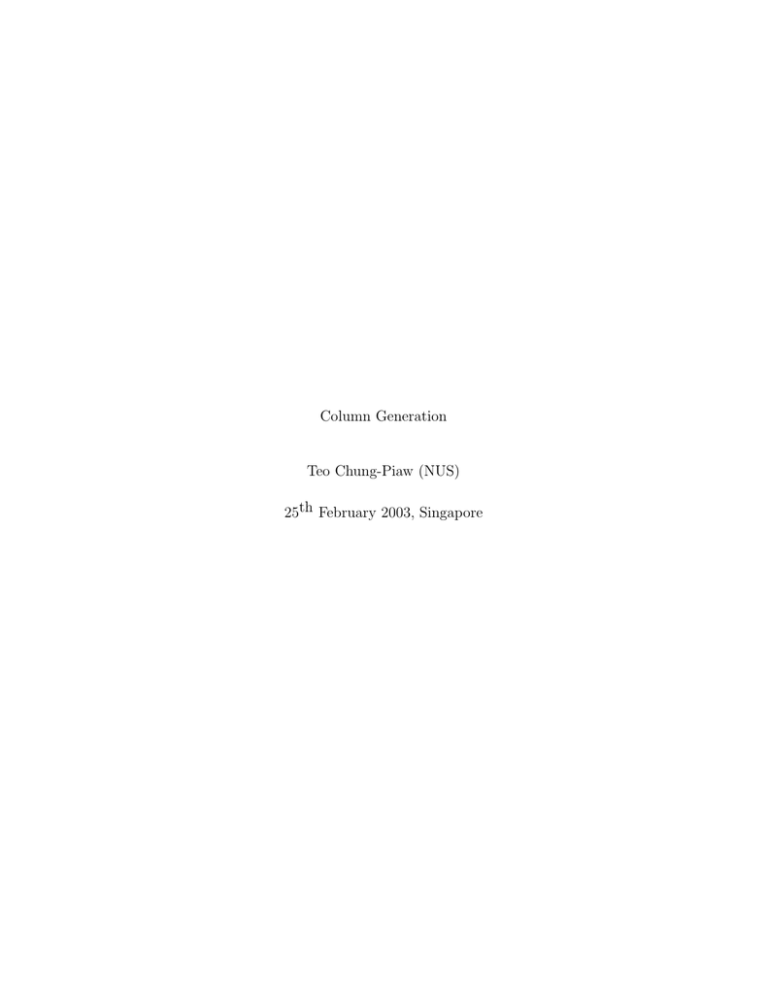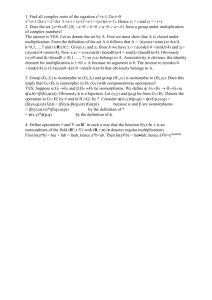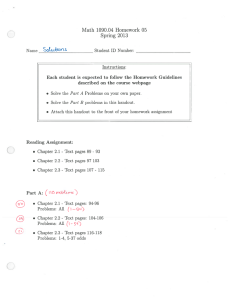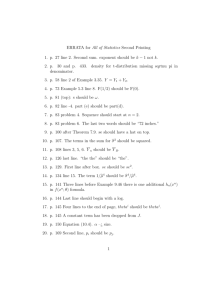Column Generation Teo Chung-Piaw (NUS)
advertisement

Column Generation
Teo Chung-Piaw (NUS)
25th February 2003, Singapore
1
Lecture
1.1
Outline
Slide 1
• Cutting Stock Problem
• Classical Integer Programming Formulation
• Set Covering Formulation
• Column Generation Approach
• Connection with Lagrangian Relaxation
• Computational issues
2
Cutting Stock Problem
2.1
2.1.1
Introduction
Example
• A paper company has a supply of large rolls of paper, each of width W .
Slide 2
Slide 3
• Customers demand ni rolls of width wi (i=1, . . . , m). (wi ≤ W )
Example:
Quantity Ordered ni
97
610
395
211
Order Width (inches) wi
45
36
31
14
Slide 4
• The demand can be met by slicing a large roll in a certain way, called a
pattern.
• For example, a large roll of width 100 can be cut into
1
– 4 rolls each of width 25, or
– 2 rolls each of width 35, with a waste of 30.
3
Solution Approach I
3.1
3.1.1
L. V. Kantorovich
Formulation
Slide 5
(1939 Russian, 1960 English) “Mathematical Methods of Planning and Organising Production” Management Science, 6, 366-422.
• K: Set of available rolls.
• y k : 1 if roll k is cut, 0 otherwise.
• xki : number of times item i is cut on roll k.
Objective: To minimize the number of rolls used to meet all the demand
yk
min
k∈K
Slide 6
Constraints
• Total number of times item i is cut is not less than the demand.
xki ≥ ni
k∈K
• The width of a roll is at most W
wi xki ≤ W y k
i
2
min
s.t.
Slide 7
k∈K
k∈K
xki ≥ ni
yk
for a fixed item i,
k
i wi xi
k
≤ W y for fixed roll k,
xki
≥ 0, 0 ≤ y k ≤ 1
Integrality constraints on all variabes
3.1.2
Quality of Solution
Slide 8
Scenario I: N1
• ni : uniform, between 1 and 100 (rand(100)+1);
• wi : uniform, between 1 and 30 (rand(30)+1);
• Width of Roll, W = 3000;
Rolls
30
50
100
200
Items
60
100
200
400
constr
90
150
300
600
Note 1
variables
1830
5050
20100
80200
CPU (s)
2.8
14.33
179
3048
Code
The OPL code for the problem:
3
Slide 9
Scenario II: Change width of the roll from 3000 to 150.
Rolls Items constr variables CPU (s)
70
10
80
770
3.18 - never
140
20
160
2940
58.28 - never
210
30
240
6510
Out of memory
The performance has deteriorated. Why?
How good is the LP relaxation?
wi ni
Observation: ZLP = iW . N2
This bound is trivial: The objective is to
min
yk
Slide 10
k∈K
the optimal solution will satisfy:
• Choose y k as small as possible. Therefore
wi xki = W y k
i
for all k
Slide 11
• Choose xki as small as possible. Therefore
xki = ni
k
4
for all i.
yk
=
k∈K
=
wi xk
wi
i
i
xki
=
W
W
i k∈K
k∈K
wi ni
wi k
xi =
W
W
i
i
k∈K
Note 2
Proof
We have the constraints
wi xki ≤ W y k .
i
In the LP, since the objective is to minimize k y k , the optimal LP solution
will be such that
k
i wi xi
= yk .
W
y k will be small if the xki values are small. At the same time, because
xki ≥ ni ,
k∈K
to make
xki
small, at the optimal solution, we must have
xki = ni .
k∈K
So the objective function, for the optimal LP solution, reduces to
wi xk
i
i
yk =
W
k∈K
k∈K
wi
xik
=
W
i k∈K
wi =
xik
W
i
k∈K
wi ni
=
W
i
Slide 12
Another Example: W = 273
Quantity Ordered
233
310
122
157
120
Order Width (inches)
18
91
21
136
51
5
• LP: solved in 0.27s. Solution 228.7106.
• IP: halted after 12 hours of computational time!
4
Approach II
4.1
4.1.1
Gilmore and Gomory
Set Covering
P. C. GILMORE AND R. E. GOMORY, A linear programming approach to the
cutting-stock problem, Oper. Res., 8 (1961), pp. 849-859.
xj = number of times pattern j is used
aij = number of times item i is cut in pattern j
For example, a large roll of width 100 can be cut into
Slide 13
• 4 rolls each of width wi = 25 (pattern j, aij = 4)
• 2 rolls each of width wk = 35 (pattern l, akl = 2)
min
s.t.
Slide 14
n
xj
i = 1, . . . , m,
j=1 aij xj ≥ ni ,
xj ∈ Z + , j = 1, . . . , n
n
j=1
Slide 15
Example: An instance: W = 100, m = 3.
wi
25
35
45
1
4
0
0
2
2
1
0
pattern
3 4
2 1
0 2
1 0
5
0
1
1
6
0
0
2
ni
150
200
300
Slide 16
Another way to formulate the cutting stock problem:
x1
4x1 +
0x1 +
0x1 +
minimize
x2
x3
x4
2x2 + 2x3 + 1x4 +
1x2 + 0x3 + 2x4 +
0x2 + 1x3 + 0x4 +
6
x5
0x5 +
1x5 +
1x5 +
xj
x6
0x6 ≥
0x6 ≥
2x6 ≥
j=1
RHS
150
200
300
xj = number of rolls to be cut using pattern j.
4.1.2
Computational Issues
Slide 17
Linear relaxation: (LP)
min
s.t.
n
x
n j=1 j
j=1 aij xj ≥ ni , i = 1, . . . m,
xj ≥ 0, j = 1, . . . , n
6
• LP solution provides a lower bound to IP.
How to solve (LP)?
Slide 18
• Feasible patterns: all nonnegative integer vectors (z1 , . . . , zm ) satisfying
m
wi zi ≤ W
i=1
• Not all feasible patterns are needed in the above formulation.
Issue: In the constraint matrix A, the number of decision variables (i.e., number
of feasible patterns) is large!
5
Cutting Stock Problem
5.1
5.1.1
Column Generation
Algorithm
1. Start with a basic feasible solution B.
Slide 19
For example, use the simple pattern to cut a roll into W/wi rolls of
width wi . (The basis matrix is a diagonal matrix.)
m
2. For any pattern j, reduced cost is 1 − i=1 πi aij , where (π1 , . . . , πm )
(=cB B−1 ) is the simplex multipliers vector associated with the current
basis.
3. Identify a pattern with negative reduced cost, or prove that none exists.
Update basis and repeat.
Slide 20
For instance, we may want to find the column with most negative reduced cost:
m
1 − i=1 πi xi
Z ∗ (π) = min
subject to
i wi xi ≤ W, xi integral.
• If Z ∗ (π) ≥ 0, all columns have negative reduced cost!
• Otherwise, the solution gives rise to a column with negative reduced cost!
5.1.2
Identifying Columns
m
min
subject to
1 − i=1 πi xi
i wi xi ≤ W, xi integral.
is equivalent to solving m
Z (π)
= max i=1
πi xi
subject to
i wi xi ≤ W , xi integral.
7
Slide 21
5.1.3
Knapsack problem
Z � (π) = max
subject to
m
πi x i
i=1
i
Slide 22
wi xi ≤ W,
xi integral.
• The column generation method depends critically on how fast we can solve
the knapsack problem.
• How difficult is it to solve the knapssack problem?
Computational Result on random instances using the MIP solver from CPLEX:
n
1,000
10,000
100,000
Slide 23
CPU (s)
0.22
1.04
75.52
More specialized algorithm can be used to solve the Knapsack problem efficiently
in practice.
5.1.4
How Good is the bound?
Slide 24
Number of items = 5.
Tested on several instances:
Optimal
15
11
34
19
Col Gen (LP)
14.0533
10.4733
33.0989
18.2867
Round Up Conjecture:
ZIP ≤ ZLP ?
Slide 25
Unfortunately, this is not true:
• W = 273
•
w1 = 18
w2 = 91
w3 = 21
w4 = 136
w5 = 51
n1
n2
n3
n4
n5
= 233
= 310
= 122
= 157
= 120
8
ZLP (CG) = 228.9982. ZIP = 230. N3
Note 3
Round Up Conjecture
In 1985 the theoretical result of Marcotte (The cutting stock problem and integer
rounding, Math. Programming, 33 (1985), pp. 82-92) shed light on the relationship between solutions of the LP relaxation and the cutting stock problem
itself. She proved that for some practical instances of the problem a so-called
round-up property is valid. It means that to find the optimal value of the cutting stock problem, it is sufficient just to solve the LP relaxation and to round
up the value of the objective function.
Unfortunately, this conjecture is not true for all instances of the cutting stock
problem. Fieldhouse (The duality gap in trim problems, SICUP-Bulletin No.
5, 1990) presents an example of the cutting stock problem with a gap of 1.0333.
This gives rise to the “modified” round up conjecture.
5.1.5
Modified Round Up Conjecture
ZIP ≤ ZLP + 1?
Slide 26
• This conjecture has not been answered.
• Can you disprove it?
5.1.6
Getting Intergal Solution
The solution obtained from solving the column generation problem may frac
tional.
How to obtain integral solution?
Slide 27
- round up the fractional solution. (e.g., change 18.3 to 19).
- round down the fractional solution, and resolve the problem with smaller
set of demand.
- branch and bound to obtain the optimal integral solution
5.1.7
Rounding Up
• Let xj be the (fractional) LP solution obtained from the column generation
method.
• Let xj = xj . xj integral.
•
j ai,j xj ≥ ni implies
j ai,j xj ≥ ni . So xj defined in this way is a
feasible integral solution.
• How good is this heuristic?
9
Slide 28
Slide 29
W = 273
w1 = 18
w2 = 91
w3 = 21
w4 = 136
w5 = 51
n1
n2
n3
n4
n5
= 233
= 310
= 122
= 157
= 120
• ZLP (CG) = 228.9982.
• Round-Up produces a solution of 231
Slide 30
cut
cut
cut
cut
cut
cut
cut
Round-Up
0
104
9
79
0
24
15
Fractional
0.0000
103.3333
8.2363
78.5000
0.0000
24.0000
14.9286
18
15
0
0
0
0
1
14
91
0
3
0
0
0
0
0
21
0
0
13
0
0
0
1
136
0
0
0
2
0
0
0
51
0
0
0
0
5
5
0
Disadvantages of the round-up heuristic?
6
6.1
6.1.1
Column Generation
Dual Perspective
Lagrangian Relaxation
How would you use LR to solve the cutting stock problem?
K
k
min
k=1 y
K
s.t.
xk ≥ ni ∀ i = 1, 2, . . . , m,
mk=1k i
k
∀ k = 1, . . . , K,
i=1 xi wi ≤ W y
Slide 31
y k ∈ {0, 1} ∀ k,
xki ≥ 0, xki integral
Which constraints would you relax?
Suppose you relax the first class of constraints:
L(u) = min
s.t.
K
k
K
k
i=1 ui ni −
k=1 xi
m
k=1
y +
i=1
xki wi ≤ W y k ∀ k = 1, . . . , K,
m
y k ∈ {0, 1} ∀ k,
xki ≥ 0, xki integral
10
Slide 32
where ui ≥ 0 for all i.
Slide 33
L(u) =
K
Lk (u) +
u i ni
i=1
k=1
where
m
m
y k − i=1 ui xik
m k
k
s.t.
i=1 xi wi ≤ W y
k
y ∈ {0, 1}
Lk (u) = min
xki ≥ 0, xki integral
Lk (u) is the minimum of the two values: zero (when y k = 0), or 1-Z ∗ (when
y k = 1) , where Z ∗ is obtained by solving the knapsack problem
m
Z ∗ = max
ui xki
m i=1k
s.t.
i=1 xi wi ≤ W
Slide 34
xki ≥ 0, xki integral
The subproblem in Lagragian Relaxation reduces again to a Knapsack problem!
Slide 35
Proposition: N4
• maxu≥0 L(u) = ZLP (CG).
• The optimalLanagrangian multiplers is the LP dual multiplers to the
N
constraints j=1 ai,j Kλj ≥ ni in the column formulation.
• Lagrangian relaxation solves the dual of the column formulation!
Note 4
Derivation of proposition
L(u) =
K
Lk (u) +
m
ui ni
i=1
k=1
The value Lk (u) does not depend on the index k.
L(u) = KL(u) +
m
ui ni
i=1
where
L(u) = min
s.t.
y−
m
m
i=1
ui xi
xi wi ≤ W y
y ∈ {0, 1}
i=1
xi ≥ 0, xi integral
11
• Let zj = (a1,j , . . . , am,j ), j = 1, . . . , N be the extreme points of the polytope
m
xi wi ≤ W, xi ≥ 0, xi integral.
i=1
• L(u) = min(0, 1−maxj=1,...,N
m
i=1
ai,j ui ) = minj=1,...,N min(0, 1−
L(u) = KL(u) +
m
m
i=1
ui ni
i=1
The Lagrangian Dual
max L(u) =
u≥0
m
max min
ai,j ui )
K min(0, 1 −
u≥0 j=1,...,N
+
m
i=1
ui ni
i=1
reduces to
s.t.
max y
m
y ≤ i=1 ui ni
m
m
y ≤ K(1 − i=1 ui ai,j ) + i=1 ui ni
for the zero extreme point
for the jth extreme point
ui ≥ 0 ∀ i = 1, . . . , m.
Equivalently,
max
m
y
(λ0 )
y − i=1 ui ni ≤ 0
m
m
(λj ) y + K( i=1 ui ai,j ) − i=1 ui ni ≤ K
ui ≥ 0 ∀ i = 1, . . . , m.
λ0 , λj are the associated dual variables.
The dual of this problem:
N
min
j =1 Kλj
N
λ0 + j=1 λj = 1
N
N
−ni (λ0 + j=1 λj ) + j=1 ai,j Kλj ≥ 0.
λj ≥ 0 ∀ j = 1, . . . , N.
This is just
min
j =1 Kλj
N
12
ai,j ui )
λ0 +
N
N
j=1
λj = 1
j=1 ai,j Kλj ≥ ni
λj ≥ 0 ∀ j = 1, . . . , N.
N
For K large, the constraint λ0 + j=1 λj = 1 is redundant – as long as there
N
is a feasible solution λj with j =1 λj ≤ 1
Let xj = Kλj . We obtain the column formulation of the cutting stock problem
!
6.2
Lagrangian Relaxation
6.2.1
Comparison
Slide 36
• The bounds obtained by both methods are identical.
• Which method is better?
Column Generation
Primal, dual optimal solution
(Primal) Bounds monotone
Dual solution zig-zag
LP solver needed
6.3
Langrangean Relaxation
Dual but not primal solution
(Dual) Bounds zig-zag
Dual solution suitably selected
Easy to implement
Speeding Up
6.3.1
Column Selection
Slide 37
• Prevent generation
of redundant
columns.
T
Instead of minj cj − π Nj , solve
min
j:π T Nj >0
cj
,
π T Nj
cj − π T N j
min
.
j
1 T Nj
or
Slide 38
c −π T N
• minj cj − π T Nj versus minj j 1T Nj j
cut
cut
cut
cut
cut
cut
cut
Round-Up
0
104
9
79
0
24
15
Fractional
0.0000
103.3333
8.2363
78.5000
0.0000
24.0000
14.9286
18
15
0
0
0
0
1
14
13
91
0
3
0
0
0
0
0
21
0
0
13
0
0
0
1
136
0
0
0
2
0
0
0
51
0
0
0
0
5
5
0
• Maintain a column pool.
Check for columns with negative reduced cost in the column pool before
solving the pricing subproblem. Replenish the column pool everytime you
solve a pricing subproblem.
6.3.2
Dual Selection
Slide 39
Restrict domain of dual prices
Use properties of optimal dual prices to restrict the domain.
In the cutting stock problem, suppose the orders are ranked such that w1 <
w2 < . . . < wm , then it is easy to see that the dual prices satisfy:
π1 ≤ π2 ≤ . . . ≤ πm .
Translating into the primal, this is equivalent to adding the following columns
with zero cost to the primal problem:
1
0
0
−1 1
···
0 −1
···
··· , 0 , ... ···
··· ···
0
··· ···
1
0
0
−1
7
Column Generation
7.1
7.1.1
Applications
Examples
Other application of column generation:
Slide 40
Vehicle Routing with time window or other types of constraint:
• A set of m customers.
• Each customer must be served within certain time window.
• Find a set of routes to serve all the customers, so that each customer will
be visited by a vehicle within the stipulated time window.
Here each column may represent a feasible trip. One likely objective is to find
minimal number of vehicles to cover all the customers.
14
Slide 41
Column generation phase now reduces to the following: Given a profit πi for
each demand point, find a route that satisfies:
Slide 42
• feasibility constraints (meet the time window constraints);
• total profits accrued by serving the demand points on the route is maxi
mum - a variant of the TSP problem.
N5
Note 5
Papers
• J. Desrosiers, Y. Dumas,F. Soumis & M. Solomon. Time Constrained
Routing and Scheduling, Handbooks in OR & MS, 8 (1995)
• G. Desaulniers et al. A Unified Framework for Deterministic Vehicle Routing and Crew Scheduling Problems T. Crainic & G. Laporte (eds) Fleet
Management & Logistics (1998).
8
Conclusions
• Column Generation has been successfully used to solve many large scale
integer programming problem arising in the industry.
• Able to handle large scale model that standard commercial MIP solver
cannot handle.
• Ability to solve the pricing subproblem efficiently is key to the approach
• Connection between Column generation and Lagragian Relaxation
• Non-linearities occuring in practical problems taken care of in the subproblem (next lecture)
15
Slide 43



